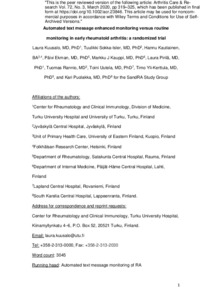Automated text message enhanced monitoring versus routine monitoring in early rheumatoid arthritis: a randomized trial
Kuusalo L; Sokka-Isler T; Kautiainen H; Ekman P; Kauppi MJ; Pirilä L; Rannio T; Uutela T; Yli-Kerttula T; Puolakka K; SandRA Study Group.
https://urn.fi/URN:NBN:fi-fe2021042823375
Tiivistelmä
OBJECTIVE:
Frequent monitoring of early rheumatoid arthritis (RA) patients is required for achieving good outcomes. We studied the influence of text message (SMS) enhanced monitoring on early RA outcomes.
METHODS:
We randomized 166 early, disease-modifying antirheumatic drug naive RA patients to SMS-enhanced follow-up or routine care. All patients attended visits at 0, 3, and 6 months, and a follow-up visit at 12 months. Treatment was at the physicians' discretion. The intervention included 13 SMSs during weeks 0-24 with questions concerning medication problems (yes/no) and disease activity (patient global assessment [PGA], scale 0-10). If response SMSs indicated medication problems or PGA exceeded predefined thresholds the patients were contacted. Primary outcome was 6-month Boolean remission (no swollen or tender joints, normal CRP). Quality of life (QOL, Short Form 36) and 28-joint disease activity scores (DAS28) were assessed.
RESULTS:
Six and 12-month follow-up data were available for 162 and 157 patients. In the intervention group, 47% (38/82) of the patients reported medication problems and 49% (40/82) of the patients reported SMS-PGAs above the alarm limit. Remission rates in the intervention and control groups were 51% and 42% at 6 months (p=0.34); and 57% and 43% at 12 months (p=0.17). The respective DAS28 scores were 1.92±1.12 and 2.22±1.11 at 6 months (p=0.09); and 1.79±0.91 and 2.08±1.22 at 12 months (p=0.28). No differences in QOL were observed.
CONCLUSION:
The study failed the primary outcome despite a trend favoring the intervention group. This may be explained by the notably high overall remission rates. This article is protected by copyright. All rights reserved.
Kokoelmat
- Rinnakkaistallenteet [27094]
